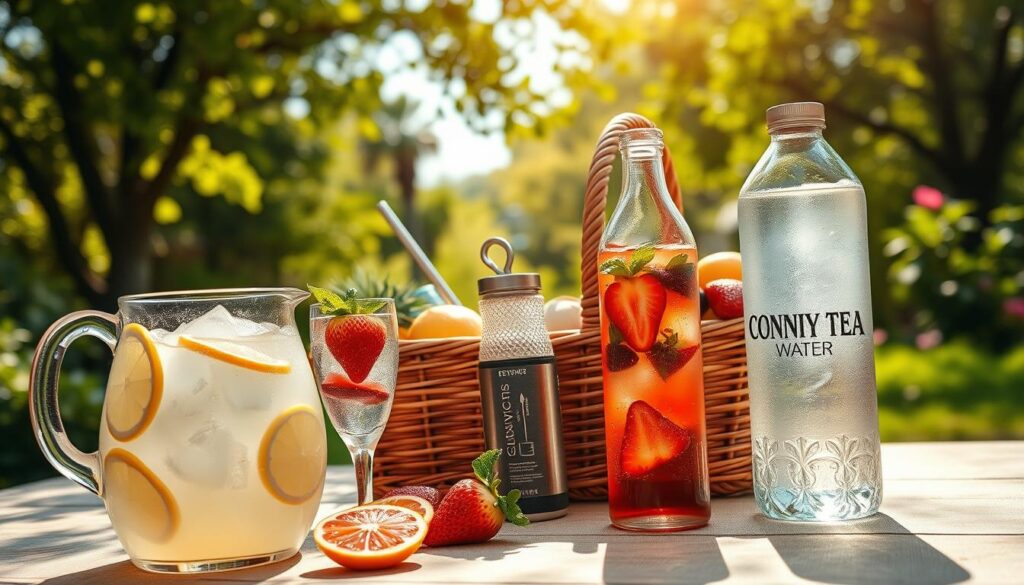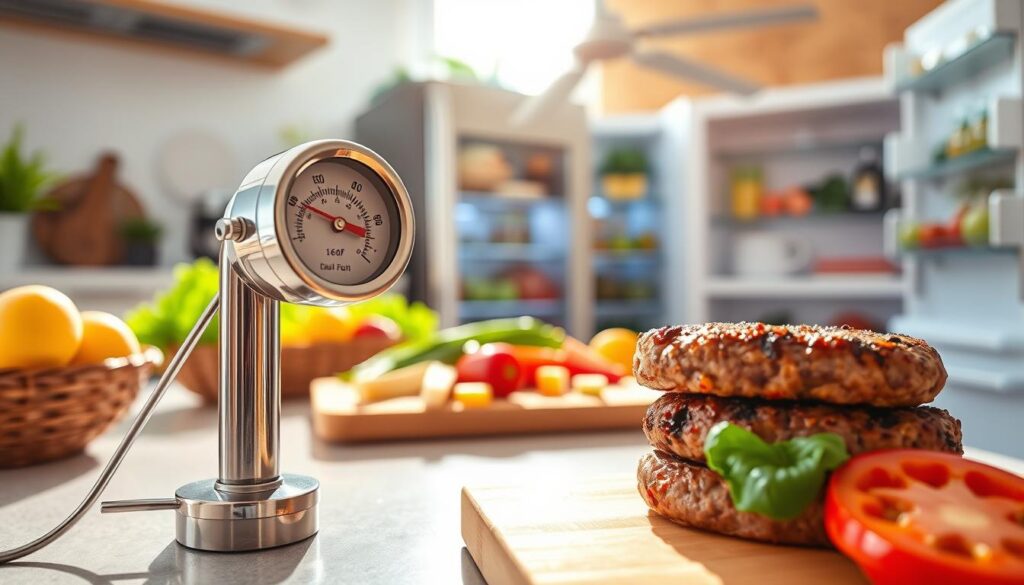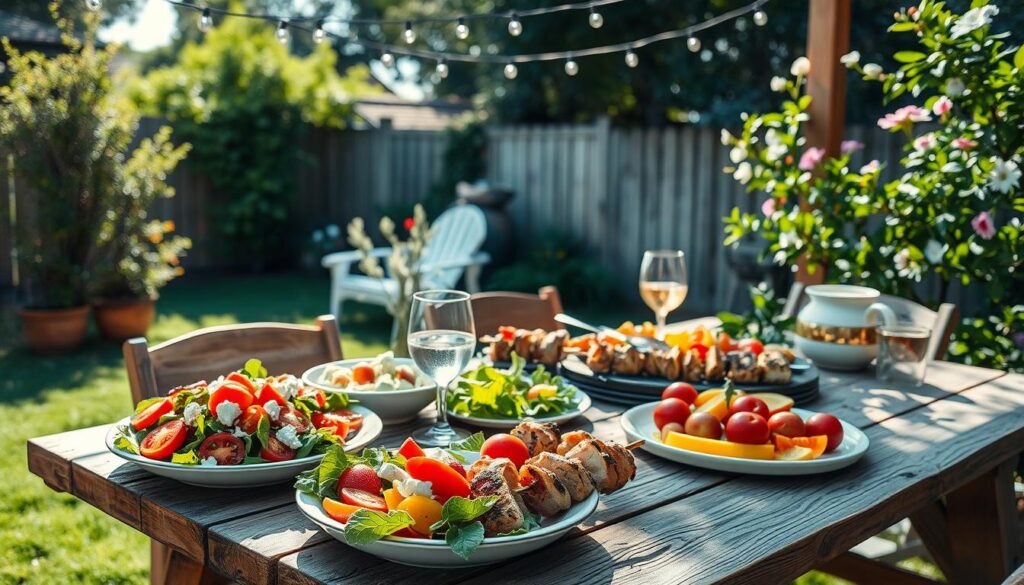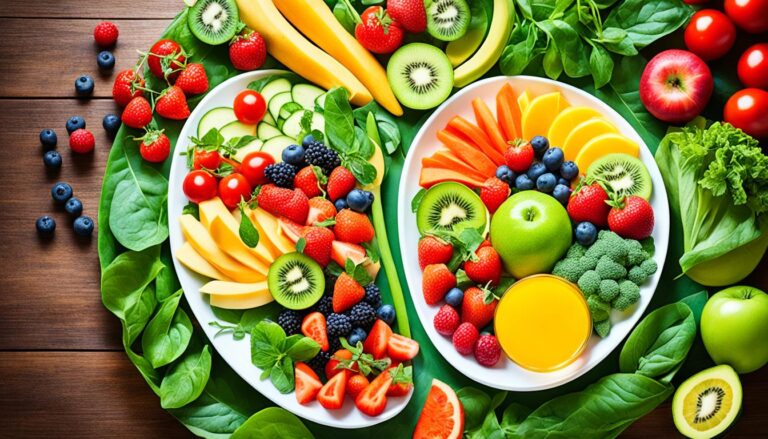Are you struggling to maintain proper nutrition while the temperature rises and your appetite changes? Warmer weather brings unique challenges that can derail even the most dedicated wellness routines.
Summer months present distinct obstacles for maintaining balanced eating habits. Decreased appetite, increased social gatherings, and food safety concerns in hot temperatures create a perfect storm of nutritional challenges. Many Americans find themselves skipping meals, overindulging at barbecues, or relying on processed convenience foods.
However, this season also offers incredible opportunities. Fresh, locally-sourced produce reaches peak availability. Professional nutritionists recognize summer as an ideal time to revitalize eating patterns with vibrant, nutrient-dense foods.
This comprehensive guide presents evidence-based strategies that work together seamlessly. These approaches support optimal hydration, sustained energy levels, and overall wellness during the warmest months. Each recommendation addresses specific warm-weather concerns while maximizing seasonal advantages.
Key Takeaways
- Summer weather creates unique nutritional challenges requiring adapted eating strategies
- Fresh, seasonal produce offers maximum nutritional benefits during warmer months
- Proper hydration becomes critical for maintaining energy and health in heat
- Food safety practices must be heightened during hot weather conditions
- Social dining situations require mindful approaches to maintain balanced nutrition
- Strategic meal timing can help combat decreased appetite in warm weather
Summer Dining Challenges and Opportunities
Summer’s arrival shifts the dynamics of nutritious eating, offering both challenges and remarkable opportunities. The season creates a complex landscape where maintaining healthy summer meals requires strategic planning and awareness.
Rising temperatures naturally suppress appetite while simultaneously increasing your body’s need for proper hydration and electrolyte balance. This physiological response can disrupt regular eating patterns. Food spoilage becomes a pressing concern as heat accelerates bacterial growth, making food safety protocols more critical than ever.
Vacation schedules and social gatherings often derail established seasonal eating habits. Barbecue events tempt with calorie-dense options, while sugary beverages seem more appealing in hot weather. These social pressures can quickly undermine nutritional goals.
“Summer eating patterns can make or break your annual health goals, but the season also provides nature’s best nutritional toolkit.”
However, summer presents unparalleled advantages for healthy eating. Fresh, nutrient-dense produce reaches peak ripeness and affordability during these months. Farmers’ markets overflow with colorful vegetables and fruits packed with vitamins and antioxidants.
Extended daylight hours provide more time for meal preparation and planning. Your body naturally craves lighter, more refreshing foods that align perfectly with nutritional wellness. This biological inclination creates an ideal foundation for establishing sustainable seasonal eating habits.
Understanding these dual forces allows you to maximize summer’s nutritional benefits while effectively managing its unique challenges. The following eight tips will help you navigate this seasonal complexity successfully.
8 Healthy Tips for Summer Dining: Your Complete Guide
The warm weather months bring distinct dietary considerations that impact both food safety and nutritional optimization. These eight interconnected strategies form a comprehensive framework designed specifically for summer dining success.
Each tip addresses unique physiological needs that emerge during hot weather. Professional nutritionists emphasize that summer food safety becomes critical when temperatures rise above 85°F. The combination of heat exposure and increased outdoor activities creates specific challenges for maintaining proper nutrition.
Registered dietitians recommend this systematic approach because it tackles multiple aspects simultaneously. The framework covers seasonal produce utilization, temperature management, and meal timing optimization. These evidence-based strategies work together to support immune function and prevent dehydration-related health issues.

Smart implementation focuses on practical meal planning techniques that busy professionals can adopt immediately. The guide emphasizes flexible hydration strategies that accommodate various lifestyles and dietary preferences. Each recommendation maintains nutritional integrity while addressing real-world social dining situations.
The collective benefit extends beyond summer months through habit formation. These techniques create sustainable eating patterns that improve year-round wellness. Professional implementation strategies include smart shopping methods, safe food transportation, and social event navigation skills.
Success depends on understanding how these tips interconnect rather than applying them in isolation. The framework adapts to different climates, activity levels, and personal health goals. This comprehensive approach ensures that summer dining enhances rather than compromises your nutritional objectives while maintaining the social enjoyment that defines the season.
Tip 1: Embrace Fresh, Seasonal Produce
Summer’s abundance of fresh produce offers unparalleled opportunities to enhance your nutritional intake while enjoying peak flavors. The warm season delivers nature’s most nutrient-dense foods at their absolute best. Fresh produce benefits extend far beyond basic nutrition, providing natural cooling properties and essential electrolytes your body craves during hot weather.
Seasonal eating connects you with nature’s rhythm while supporting your health goals. Summer fruits and vegetables reach maximum nutritional value when harvested at peak ripeness. This timing ensures you receive the highest concentration of vitamins, minerals, and antioxidants available.
Best Summer Fruits for Optimal Nutrition
Berries lead the pack for antioxidant power and immune support. Blueberries, strawberries, and raspberries provide vitamin C and fiber while fighting inflammation. Stone fruits like peaches, plums, and apricots offer beta-carotene and natural sweetness for light summer recipes.
Melons deserve special attention for their hydrating properties. Watermelon contains over 90% water plus lycopene for heart health. Cantaloupe provides vitamin A and potassium for proper muscle function during summer activities.
Nutrient-Dense Summer Vegetables
Leafy greens thrive in summer heat and provide folate, iron, and vitamin K. Spinach, arugula, and lettuce create perfect bases for refreshing salads. Tomatoes reach peak flavor while delivering lycopene and vitamin C for skin protection.
Cucumbers and bell peppers add crunch and hydration to meals. These vegetables contain high water content plus essential nutrients. Zucchini and summer squash offer versatility for both raw and cooked preparations in light summer recipes.
Smart Shopping Strategies for Peak Freshness
Visit farmers’ markets early morning for the best selection and freshness. Local vendors harvest produce at optimal ripeness, ensuring maximum fresh produce benefits. Build relationships with growers to learn about upcoming harvests and storage tips.
Learn to identify ripeness indicators for different fruits and vegetables. Gentle pressure, color changes, and aroma provide clues about peak quality. Proper storage techniques extend freshness and maintain nutritional value once you bring produce home.
Plan weekly menus around seasonal availability to maximize both nutrition and budget efficiency. Purchase larger quantities of peak-season items for preservation through freezing or dehydrating methods.
Tip 2: Stay Hydrated with Smart Beverage Choices
Summer heat transforms hydration from a simple daily habit into a strategic health priority that demands smart beverage choices. Your body loses fluids rapidly through increased sweating and breathing during hot weather activities. This makes proper hydration essential for maintaining energy levels and supporting your body’s natural cooling systems.
Strategic beverage selection becomes even more critical when you’re planning outdoor dining safety measures or preparing healthy grilling options for summer gatherings. The right drinks help regulate body temperature while providing essential nutrients your body needs during extended outdoor activities.

Creative Infused Water Combinations
Transform plain water into refreshing beverages using natural flavor enhancers. Cucumber and mint create a cooling combination that helps lower body temperature. Citrus fruits like lemon, lime, and orange provide vitamin C while adding natural sweetness without added sugars.
Berry combinations offer antioxidants alongside hydration benefits. Try strawberry-basil or watermelon-rosemary for unique flavor profiles. These infused waters stay fresh for up to 24 hours when properly refrigerated, making them perfect for meal prep.
Healthy Alternatives to Sugary Summer Drinks
Replace high-sugar beverages with nutrient-dense options that support hydration goals. Coconut water provides natural electrolytes without artificial additives. Herbal iced teas offer variety while delivering beneficial compounds from herbs like chamomile or peppermint.
Homemade electrolyte drinks using sea salt, fresh citrus juice, and natural honey provide better mineral balance than commercial sports drinks. These alternatives support sustained energy during outdoor dining safety activities without the sugar crash associated with conventional beverages.
Recognizing Proper Hydration Levels
Monitor your hydration status through simple physical indicators. Pale yellow urine signals adequate hydration, while dark yellow indicates the need for increased fluid intake. Thirst represents an early warning sign, not an optimal hydration gauge.
Pay attention to energy levels and skin elasticity as additional hydration markers. Well-hydrated skin springs back quickly when pinched, while dehydrated skin remains elevated. These monitoring techniques become especially important when enjoying healthy grilling options during extended outdoor cooking sessions.
Tip 3: Master Light and Refreshing Meal Preparation
Hot summer days demand clever cooking strategies that keep your kitchen cool while delivering nutritious meals. Summer meal planning becomes effortless when you focus on techniques that minimize heat generation while maximizing flavor and nutritional value. These preparation methods help you create satisfying dishes without turning your kitchen into a sauna.
Professional chefs understand that successful warm-weather cooking relies on strategic ingredient selection and efficient preparation techniques. Cooling foods and light meals become the foundation of your summer dining experience when prepared correctly.
No-Cook Meal Solutions
No-cook meals eliminate kitchen heat while preserving maximum nutrients in fresh ingredients. Gazpacho, ceviche, and grain-based salads provide complete nutrition without requiring stovetop or oven use. These dishes often taste better after chilling, making advance preparation both practical and beneficial.
Strategic protein sources like canned beans, pre-cooked chicken, and hard-boiled eggs streamline assembly while maintaining food safety standards. Fresh ingredients shine in these preparations, offering peak flavor and nutritional density.
Quick and Healthy Grilling Techniques
Outdoor grilling keeps heat outside while creating delicious, healthy meals in minutes. Marinate proteins for 30 minutes to enhance flavor and reduce harmful compound formation during cooking. Vegetable packets wrapped in foil cook quickly while retaining moisture and nutrients.
Temperature control remains critical for food safety and optimal results. Use a meat thermometer to ensure proper doneness while avoiding overcooking. Light meals from the grill include fish fillets, chicken breasts, and colorful vegetable medleys.
Cold Soup and Salad Preparation Methods
Cold soups provide hydration and nutrition while offering cooling relief during hot weather. Blend fresh vegetables with herbs and healthy fats like avocado or olive oil for creamy textures without dairy. Chilled cucumber, watermelon, or tomato-based soups deliver refreshing satisfaction.
Substantial salads serve as complete meals when they include protein, healthy fats, and complex carbohydrates. Quinoa, farro, or bulgur wheat create filling bases for cooling foods like cucumber, mint, and citrus fruits. Make-ahead dressings and pre-chopped vegetables streamline daily assembly while maintaining freshness.
Tip 4: Practice Safe Food Handling in Hot Weather
Hot weather demands extra attention to food safety practices during meal preparation. Summer temperatures create ideal breeding conditions for harmful bacteria that can multiply rapidly in improperly handled food. Understanding proper food safety protocols protects your family from foodborne illnesses while maintaining the quality of your meals.
Effective food safety during summer requires systematic approaches to temperature management, storage methods, and handling procedures. These practices become even more important when portion control summer strategies involve preparing larger quantities of food for outdoor gatherings and extended storage periods.

Critical Temperature Control Guidelines
The temperature danger zone between 40°F and 140°F allows bacteria to double every 20 minutes. Keep cold foods below 40°F and hot foods above 140°F at all times. Use a reliable food thermometer to verify temperatures rather than relying on visual cues or guesswork.
Never leave perishable foods at room temperature for more than two hours during normal conditions. This time limit reduces to just one hour when outdoor temperatures exceed 90°F. Set timers to track how long foods remain in the danger zone during preparation and serving.
Proper Food Storage and Transportation
Pack cold foods in insulated coolers with plenty of ice or frozen gel packs. Maintain a 2:1 ratio of ice to food for optimal temperature control. Store raw meats in separate containers or at the bottom of coolers to prevent cross-contamination with ready-to-eat items.
Pre-chill coolers before adding food items to ensure immediate temperature control. Keep coolers in shaded areas and limit opening frequency to maintain internal temperatures. Consider using separate coolers for healthy summer beverages that require frequent access.
Outdoor Dining and Picnic Safety Protocols
Establish designated preparation areas away from high-traffic zones to minimize contamination risks. Use separate cutting boards and utensils for raw and cooked foods. Keep hand sanitizer readily available when soap and water aren’t accessible.
Monitor food temperatures throughout outdoor events using instant-read thermometers. Discard any perishable foods that have been in the danger zone too long, regardless of appearance or smell. Plan outdoor dining menus with food safety timelines in mind to reduce waste and health risks.
Tip 5: Balance Indulgence with Nutritious Choices
Balancing nutritious choices with occasional indulgences creates a sustainable approach to summer nutrition. This strategy allows you to enjoy seasonal favorites while maintaining your health goals. Smart substitutions and mindful eating make it possible to participate fully in summer social events.
The key lies in making informed decisions rather than avoiding social gatherings entirely. Summer nutrition tips emphasize moderation over elimination. This approach helps you build lasting healthy habits that work in real-world situations.
Healthier Barbecue and Grilling Options
Transform your grilling experience by choosing lean proteins like chicken breast, fish, or turkey burgers. These options provide essential nutrients while reducing saturated fat intake. Marinate proteins in herbs, citrus, and spices to enhance flavor without adding excessive calories.
Incorporate vegetables directly onto the grill for added nutrition and variety. Grilled zucchini, bell peppers, and corn provide fiber and vitamins while creating colorful, appealing plates. Use aluminum foil packets to steam vegetables with minimal oil.
| Traditional Option | Healthier Alternative | Nutritional Benefit |
|---|---|---|
| Beef burgers | Turkey or black bean patties | Lower saturated fat, higher fiber |
| Hot dogs | Chicken sausages | Reduced sodium and preservatives |
| Potato salad | Grilled vegetable medley | Increased vitamins and minerals |
| Sugary marinades | Herb and citrus rubs | Natural flavors without added sugars |
Effective Portion Control Strategies
Use visual cues to manage portions during buffet-style gatherings. Fill half your plate with vegetables before adding other items. This simple strategy ensures adequate fiber intake while naturally controlling portions of higher-calorie foods.
Practice mindful eating by taking smaller initial portions and returning for seconds only if truly hungry. Engage in conversations between bites to slow your eating pace. These healthy summer meals practices help you recognize fullness signals more effectively.
Nutritious Summer Dessert Alternatives
Create satisfying desserts using seasonal fruits as the primary ingredient. Grilled peaches with Greek yogurt or frozen berry parfaits provide natural sweetness with added protein and probiotics. These alternatives satisfy cravings while contributing beneficial nutrients.
Experiment with fruit-based sorbets or chia seed puddings for refreshing treats. These options deliver fiber, antioxidants, and essential minerals while maintaining the celebratory aspect of dessert. Summer nutrition tips encourage creativity in dessert preparation to maintain both health and enjoyment.
Tip 6: Optimize Meal Timing for Hot Weather
Hot weather demands a thoughtful approach to meal timing that aligns with your body’s circadian rhythms and temperature regulation. Understanding how heat affects your digestive system helps you make smarter choices about when and what to eat. Your body naturally adjusts its metabolic processes during extreme temperatures, making strategic timing essential for comfort and nutrition.
Developing effective seasonal eating habits means recognizing that your appetite and energy needs shift with the temperature. During summer months, your body works harder to maintain its core temperature, which can impact digestion and nutrient absorption. Planning your meals around these natural changes supports better health outcomes.
Strategic Eating Times During Summer Heat
Early morning hours offer the ideal window for your largest meal of the day. Between 6 AM and 8 AM, cooler temperatures allow your digestive system to work efficiently without generating excess internal heat. This timing aligns with your body’s natural cortisol peak, supporting optimal metabolism.
Late evening meals work best after 7 PM when temperatures drop and your appetite naturally returns. However, summer food safety requires careful attention to food storage and preparation during these extended daylight hours. Keep perishable items properly refrigerated until serving time.
Avoid heavy meals between 11 AM and 4 PM when heat peaks. Your body’s energy goes toward cooling rather than digestion during these hours. Light snacking with hydrating foods maintains your energy without overwhelming your system.
Light Meal Ideas for Breakfast and Lunch
Morning meals should combine protein with fresh fruits and vegetables. Greek yogurt with berries, whole grain toast with avocado, or smoothie bowls provide sustained energy without generating excessive body heat. These options support your seasonal eating habits while maintaining nutritional balance.
Midday meals benefit from cold preparations like gazpacho, grain salads, or lettuce wraps. These choices minimize cooking heat in your kitchen while delivering essential nutrients. Prepare these meals during cooler morning hours for maximum convenience and safety.
Tip 7: Incorporate Natural Cooling Foods
Strategic food choices can transform your body’s natural cooling system into an efficient temperature regulation tool. Your body responds to specific nutrients and compounds that actively support temperature control during hot weather. Understanding these natural mechanisms helps you select foods that work with your physiology rather than against it.
Effective hydration strategies extend beyond simply drinking water. Certain foods provide both hydration and cooling benefits simultaneously. This dual approach maximizes your body’s ability to maintain comfortable temperatures during summer heat.
Foods That Help Lower Body Temperature
High water content foods serve as natural cooling agents for your body. Cucumbers contain 96% water and provide essential electrolytes that support efficient perspiration. Watermelons offer 92% water content plus natural sugars that help maintain energy levels during hot days.
Leafy greens like lettuce and spinach contribute significant cooling effects through their mineral content. These vegetables support circulation while providing the fresh produce benefits your body needs for optimal temperature regulation. Tomatoes and bell peppers add both hydration and vitamin C to support your cooling systems.
Citrus fruits create cooling sensations while delivering powerful antioxidants. Oranges, grapefruits, and lemons provide natural acids that help balance your body’s pH levels during heat stress.
Cooling Spices and Herbs for Summer Dishes
Counterintuitively, certain warming spices actually promote cooling through increased circulation. Cayenne pepper and ginger stimulate blood flow, which enhances your body’s natural cooling mechanisms. This process helps distribute heat more efficiently throughout your system.
Fresh herbs provide immediate cooling relief with lasting benefits. Mint contains menthol compounds that create cooling sensations while supporting digestion. Cilantro and parsley offer fresh produce benefits through their high water content and mineral profiles.
| Cooling Food Category | Primary Cooling Mechanism | Key Benefits | Best Preparation Method |
|---|---|---|---|
| High Water Content Fruits | Hydration and electrolyte balance | Natural sugars and vitamins | Fresh, chilled consumption |
| Leafy Green Vegetables | Mineral support for circulation | Fiber and antioxidants | Raw salads or light steaming |
| Warming Spices | Enhanced blood flow | Improved heat distribution | Light seasoning in cooked dishes |
| Fresh Cooling Herbs | Menthol and aromatic compounds | Digestive support and flavor | Fresh garnish or infused waters |
Tip 8: Plan Ahead for Summer Social Events
Strategic planning transforms summer social dining from a nutritional challenge into an opportunity for healthy choices. Summer gatherings, barbecues, and restaurant outings become manageable when you prepare in advance. Successful social dining requires balancing personal health goals with social enjoyment.
Research venues beforehand to identify healthy menu options. Call restaurants to discuss dietary needs or check online menus. This preparation prevents last-minute poor choices when faced with limited options.

Healthy Potluck and Party Contributions
Bring dishes that showcase light summer recipes while appealing to diverse tastes. Fresh fruit salads, grilled vegetable platters, and quinoa-based salads offer nutritious options that guests appreciate. These contributions ensure you have healthy choices available.
Focus on outdoor dining safety when preparing potluck items. Choose recipes that maintain food safety in warm temperatures. Avoid mayonnaise-based dishes that spoil quickly. Instead, opt for vinaigrette-dressed salads or fresh salsas.
Consider dietary restrictions when planning contributions. Gluten-free grain salads, dairy-free dips, and vegetarian protein options accommodate various needs. Label dishes clearly to help guests make informed choices.
Smart Restaurant and Social Dining Strategies
Review menus online before arriving at restaurants. Identify grilled proteins, fresh salads, and vegetable-based options. This advance planning reduces decision pressure and helps you stick to healthy choices.
Practice portion control by sharing appetizers or requesting half portions. Many restaurants offer lighter menu sections specifically designed for health-conscious diners. Don’t hesitate to ask for modifications like dressing on the side or grilled instead of fried preparations.
Communicate your needs confidently but respectfully. Most restaurants accommodate reasonable requests. Eating slowly and focusing on conversation helps you recognize fullness cues and avoid overeating in social settings.
Building Long-Term Healthy Summer Eating Habits
Summer’s natural advantages provide the perfect foundation for year-round nutrition success. The abundance of fresh produce, increased social dining opportunities, and motivation for healthier choices create ideal conditions for lasting change. Sustainable habit formation requires systematic approaches that extend beyond seasonal enthusiasm.
Successful behavior change focuses on gradual implementation rather than dramatic overhauls. Start by identifying which summer practices feel most natural and enjoyable. These might include your favorite healthy grilling options or effective summer meal planning strategies that reduced stress and improved nutrition.
Professional habit formation techniques emphasize consistency over perfection. Track your progress using simple methods like weekly meal prep sessions or maintaining a food journal. Small, consistent actions build stronger foundations than sporadic intense efforts.
Common obstacles include seasonal transitions, schedule changes, and motivation fluctuations. Address these challenges by creating flexible systems that adapt to different circumstances. Prepare backup meal options, establish support networks, and develop self-compassion practices for inevitable setbacks.
| Sustainable Approach | Temporary Approach | Long-term Success Rate |
|---|---|---|
| Gradual dietary improvements | Extreme diet overhauls | 85% maintenance after 1 year |
| Flexible meal planning | Rigid eating schedules | 70% adherence long-term |
| Enjoyable healthy recipes | Restrictive food elimination | 78% continued practice |
| Social support systems | Individual willpower reliance | 92% habit maintenance |
Environmental modifications support consistent healthy choices throughout the year. Keep kitchen tools accessible, maintain organized meal planning templates, and establish shopping routines that continue providing structure beyond summer months. Success comes from building systems that make healthy choices the easiest option.
Transform Your Summer Dining Experience
These eight professional strategies create a comprehensive framework for healthier summer eating. Start with the tips that resonate most with your lifestyle. Focus on seasonal produce and smart hydration choices as your foundation.
Summer presents unique advantages for building better eating habits. Fresh ingredients are abundant and affordable. Cooling foods naturally support your body’s temperature regulation. Light meals feel more satisfying in warm weather.
Perfect adherence isn’t required for meaningful results. Choose two or three strategies initially. Master these before adding others. This approach builds sustainable habits rather than temporary changes.
Food safety awareness becomes critical during hot weather. Proper storage and handling protect your family’s health. These practices become second nature with consistent application.
Portion control summer strategies help you enjoy social gatherings without compromising your health goals. Balance indulgence with nutritious choices. Your body will respond with increased energy and better digestion.
Long-term benefits extend beyond summer months. These evidence-based approaches support immune function and sustainable weight management. They establish patterns that serve you year-round.
Adapt these recommendations to your unique circumstances. Consider your schedule, preferences, and social situations. The fundamental principles remain constant: balanced nutrition, food safety, and mindful eating choices that support optimal health throughout the season and beyond.





